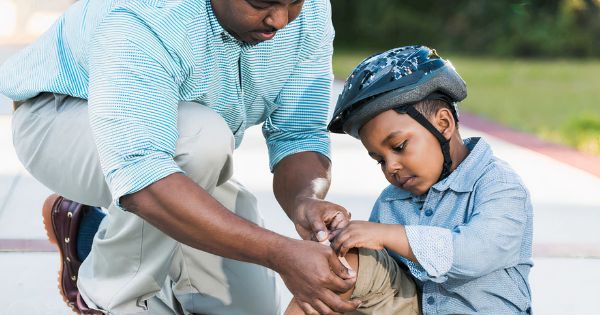While most parents prefer not to think of their children in potentially life-threatening situations, being prepared and knowing how to respond appropriately in the event of an accident, injury or illness is crucial for the well-being of children. These unexpected events can also place huge financial burdens on families if they are not dealt with quickly, decisively and correctly.

For this reason, Bestmed Medical Scheme has introduced Best Care, a life-saving first aid series that offers insights on how parents and caregivers can better care for their families. In this article the brand offers tips on first aid kits, CPR and Wound care in collaboration with some of SA’s best paediatricians.
First Aid
A fully stocked first aid kit is an essential item in every home, but it’s also a good idea to create a mini first aid kit that can be carried in a handbag, diaper bag or in the car for use during an emergency while out and about or on the road to your next holiday destination.
According to paediatrician, Dr Enrico Maraschin, having medical tools and medication that can be used to measure and control a temperature is vital. High fevers can be dangerous to the health and wellbeing of little ones if left unattended or not properly treated. It can result in convulsions, which is a stressful event for parents to witness and support their child through.
Rehydration solutions, over-the-counter medicines to bind a runny tummy and even probiotics are good items to include in your home first aid kit for children, in case your child is exposed to a virus or bacteria that can cause diarrhoea and sometimes vomiting.
Antiseptic creams, bandages to wrap wounds and a small pair of scissors to cut bandages may also come in handy in case of a fall or injury, and keep safety pins, an eye patch and adhesive dressings packed too.
CPR
Knowing how to resuscitate a child who is choking or having difficulty breathing is a necessary first aid skill that every parent and caregiver should possess, as it could help keep them alive until emergency services arrive.
Resuscitation is necessary when a child appears unresponsive, has collapsed or is gasping for air and struggling to breathe. It’s always best, of course, to intercede and assist a child as early on as possible – always take signs of breathing difficulty seriously and don’t wait for the child to collapse before taking action.
The first abbreviation to keep in mind is SSS – Safety, Shout and Stimulate.
Safety: Look at the immediate environment around you and ascertain whether it’s safe to attend to the child here or if they need to be moved to safety. It might seem simple enough, but in a moment of panic it’s easy to lose sight of this very important step.
Shout: Call for help from people nearby, phone the emergency services or get someone to call an ambulance for you.
Stimulate: Check if the child is responsive by gently tapping their arm, stroking their face or speaking to them. If the child does not groan or move and is unresponsive, quickly move on to the ABC.
ABC is a CPR abbreviation that stands for Airway, Breathe, and Circulation.
Airway: Make sure the child’s head and neck are aligned and that their body is positioned in a straight position – don’t let the neck flex as this prevents air from reaching the lungs.
Breathe: In the case of infants and babies, place your mouth over their nose and mouth to create a seal. For bigger babies and children, pinch the nose and place the mouth over just their mouth.
Circulation: There are three steps involved in this section:
- Step one: Take a breath and breathe into the mouth, making sure that the chest rises.
- Step two: Wait for the chest to deflate to normal position
- Step three: Repeat the first step.
You can continue this cycle five times. If the child is still not responsive, move on to chest compressions. While the technique varies between younger and older children, the gist remains the same.
For infants, use two fingers or a hand circling technique to apply compressions. For older children who are above the age of one, use one or two hands curled around the other to press on to the breastbone (the same would apply for an adult). Use quick compressions, positioning yourself directly over the chest and keeping the elbows straight.
“You need to do the compressions at a rate of 100 to 120 seconds. Singing a song like ‘Staying Alive’ in your head and compressing to the beat will help you to do this,” says paediatrician, Dr Kevanya Coopoo.
Alternate between compressions and administering rescue breaths, and continue this until help arrives, the child is responsive, or you are too fatigued.
“I always recommend that families go for basic life support courses. Have a look at the Resuscitation Council of South Africa’s website for a range of courses to choose from,” says Dr Coopoo. She adds that this ensures all members of the family are aware of safety practices and are able to help one another in a crisis.
For younger children, teach them the phone numbers of emergency services so that they can call for help in an emergency.

Wound Care
Accidents happen, and when they do, they may result in wounds that require proper care and treatment to ensure they heal well. A wound is any break in the skin or injury to the tissue. It can be open (in the case of the skin being penetrated or cut) or closed (if there’s damage to underlying tissue).
“If there’s bleeding, compress the wound with a clean cloth or gauze for a few minutes until the bleeding stops. Then rinse off with clean running tap water for a few minutes. Now, clean the wound by using an alcohol-sterilised pair of tweezers to pick out any debris,” says Dr Coopoo.
Dr Coopoo adds that the wound would most likely be moist at this point, in which case an antibacterial treatment would need to be applied. For pain relief, paracetamol or ibuprofen are appropriate options, as well as keeping the child comfortable and distracted.
 Kaboutjie SA Mommy Blogs by Lynne Huysamen
Kaboutjie SA Mommy Blogs by Lynne Huysamen





This is very impprtant and im so thank full for your tips
As a mother of two toddlers,I’m happy to have learned about these tips.They’re going to help me a lot,thank you.